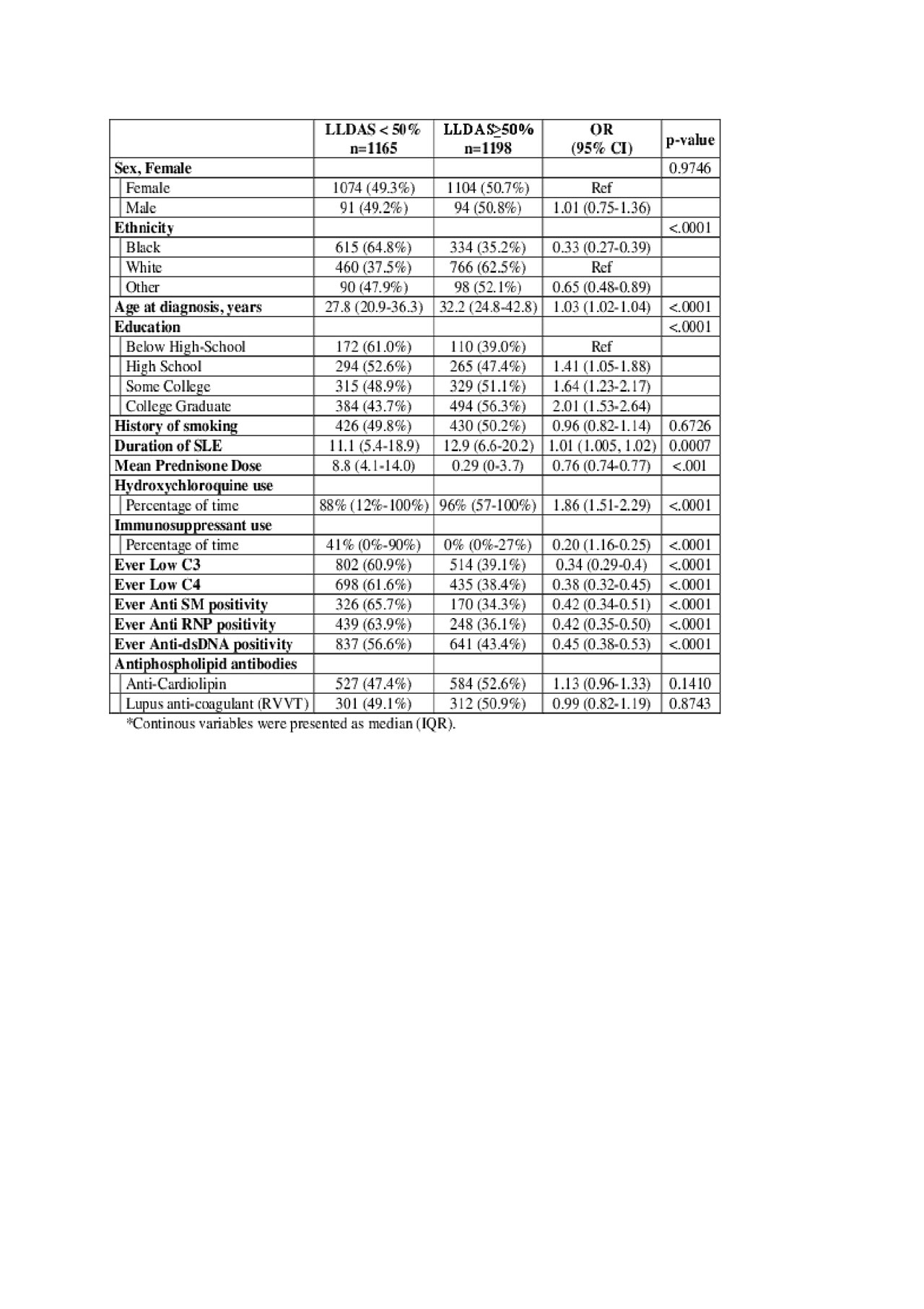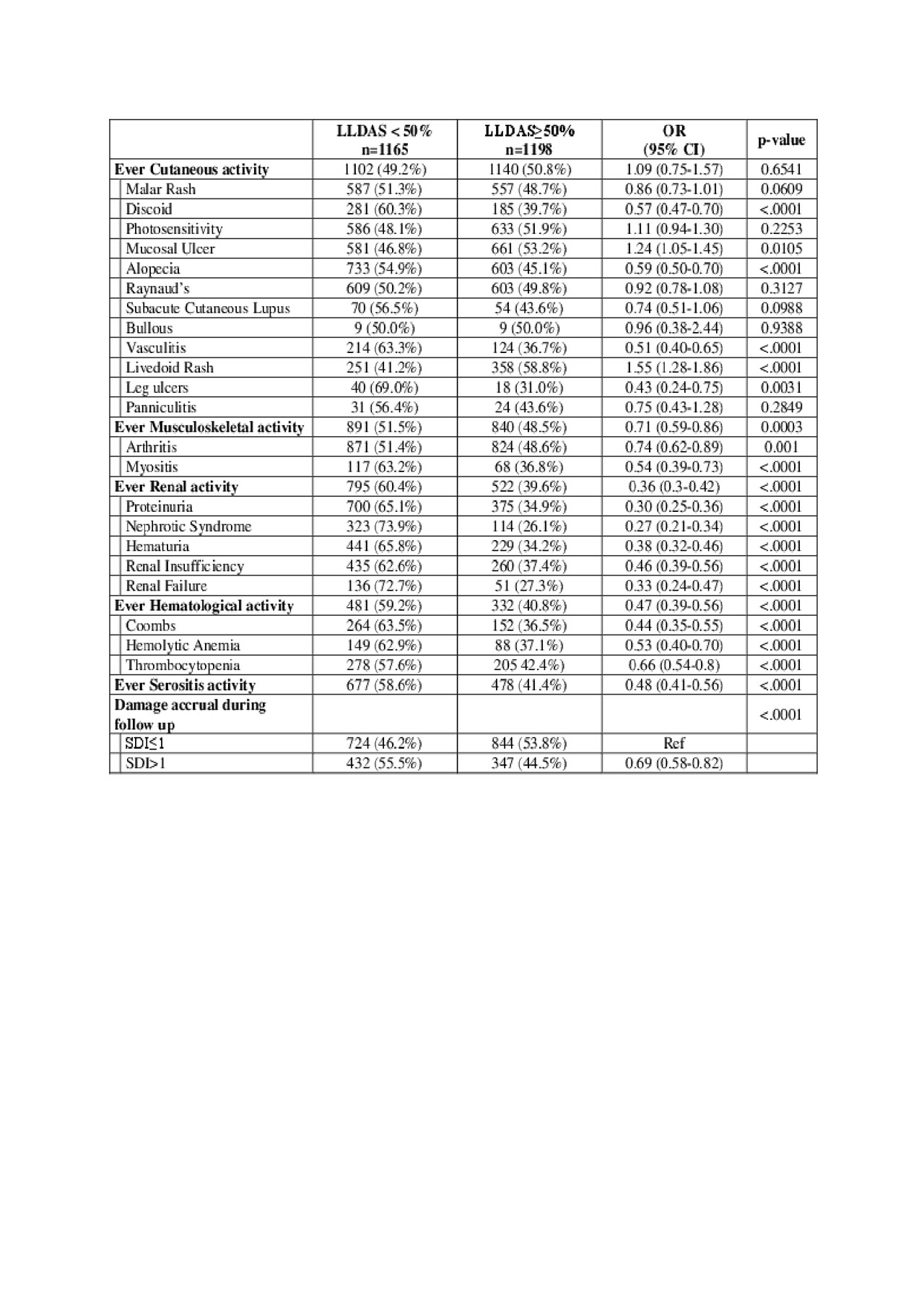Session Information
Session Type: Poster Session (Tuesday)
Session Time: 9:00AM-11:00AM
Background/Purpose: The Lupus Low Disease Activity State (LLDAS), a potential treat to target goal in systemic lupus erythematosus (SLE), has been found to correlate with reduced damage accrual in SLE. In particular, SLE patients, in LLDAS for more than half of the observation time, have a lower risk of new damage. We identified predictors of being in LLDAS over 50% of the observation time.
Methods: This analysis was based on cohort data from its inception until May, 2019. A total of 2363 SLE patients, diagnosed according to the SLICC or ACR classification criteria and with at least two clinical visits, were included. We applied the definition of LLDAS and determined whether LLDAS was satisfied at each visit for each patient. Then, each observation for each patient was defined based on the status at the following visits throughout the whole follow up. Follow up visits that occurred after a gap of more than 12 months (+/- 1 month) between clinic visits were excluded. Percentage of time in LLDAS was calculated. Durable LLDAS was defined as being in LLDAS for over 50% of the observation time. Patients were then classified into groups based on whether they had durable LLDAS or not. We analyzed the predictors of durable LLDAS from the stepwise selection procedure in logistic regression.
Results: Ninety-two percent of the patients were female, 40.2% African-American, and 51.9% Caucasian. 50% of the patients were diagnosed with SLE under the age of 30 years, 25% were between the age of 30 and 40, 14.5% were between 40 and 50, and 10.5% were diagnosed at age of 50 and over. 1198 (50.6%) patients overall, including 35.2% of African-Americans, achieved durable LLDAS. Patients with durable LLDAS, were significantly older at diagnosis, more educated, had longer disease duration, and were less likely to be African-American (Table 1,2). In the multivariable model, African-American ethnicity, ever having low C3, subacute cutaneous lupus erythematosus, alopecia, renal insufficiency, anti-RNP positivity, % of time with immunosuppressant use, and mean prednisone dose remained negative predictors, while age at diagnosis, disease duration, hemolytic anemia and higher % of time with hydroxychloroquine use remained positive predictors of durable LLDAS (Table 3).
Conclusion: A higher percentage of time with hydroxychloroquine use is a modifiable predictor of durable LLDAS, even after adjustment for clinical, demographic and other treatment variables. Only one third of African-American patients achieved durable LLDAS. Hydroxychloroquine use (and demonstration of adherence) remains essential in both clinical practice and in randomized clinical trials.

Abstract-LLDAS durationv3withoutrefheatmapsplittables-Table1

Abstract-LLDAS durationv3withoutrefheatmapsplittables-Table2

Abstract-LLDAS durationv3withoutrefheatmapsplittables-Table3
To cite this abstract in AMA style:
Babaoglu H, Li J, Goldman D, Magder L, Petri M. Hydroxychloroquine Is a Modifiable Predictor of Durable LLDAS [abstract]. Arthritis Rheumatol. 2019; 71 (suppl 10). https://acrabstracts.org/abstract/hydroxychloroquine-is-a-modifiable-predictor-of-durable-lldas/. Accessed .« Back to 2019 ACR/ARP Annual Meeting
ACR Meeting Abstracts - https://acrabstracts.org/abstract/hydroxychloroquine-is-a-modifiable-predictor-of-durable-lldas/
